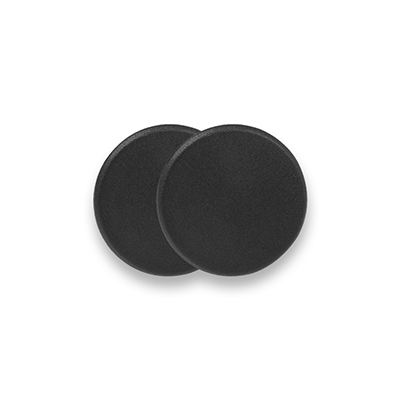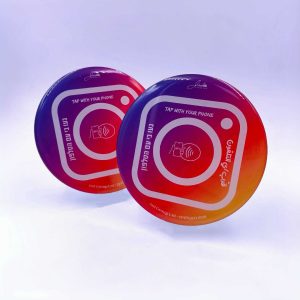RFID key fob is a small electronic device that contains a microchip and an antenna. It uses radio frequency identification (RFID) technology to communicate with an RFID reader or scanner. The key fob is typically designed to be carried on a keychain or worn as a wristband. It is used for a variety of applications, including access control, time and attendance tracking, pet management, event management, and more. RFID key fobs are available in different shapes, sizes, and materials, and can be customized with various features like unique identifiers, logos, and serial codes.
RFID key fobs work by using radio frequency identification (RFID) technology. Each key fob contains a microchip and an antenna, which communicate with an RFID reader via radio waves.
How do RFID keychains operate?
When the RFID key fob is brought close to the reader, the reader emits a radio signal, which powers the microchip in the key fob. The microchip then sends a signal back to the reader containing a unique identifier code that has been programmed into it.
The reader then checks this code against a database of authorized users to determine whether the key fob holder is allowed access. If the code is recognized as belonging to an authorized user, the access is granted. If not, access is denied.
RFID key fobs can be programmed and reprogrammed as needed, so the list of authorized users can be updated without having to replace the key fob itself.
What is the read range of an RFID key fob?
The read range of an RFID key fob can vary depending on several factors, such as the frequency used, the power of the reader, the type of antenna used, and the environment. Generally, the read range for low frequency (LF) RFID key fobs (125 kHz) is typically around 1-2 inches (2.5-5 cm), while the read range for high frequency (HF) RFID key fobs (13.56 MHz) can range from a few inches to several feet (up to 1 meter). Ultra-high frequency (UHF) RFID key fobs (860-960 MHz) can have a read range of several meters or more, depending on the reader and antenna used. It’s important to note that the read range can be affected by the presence of metal, water, and other materials that can interfere with the radio waves used by RFID systems.
8 reasons to use key fobs:
It is no surprise that key fobs are used by many establishments. The technology tightens security and simplifies some complicated jobs.
There are several reasons to use key fobs:
1.Security: Key fobs are a secure way to access restricted areas as they require the correct identification to gain access.
2.Customizable: Key fobs can be customized to include various chip types and designs, making them a versatile solution for various applications.
3.Cost-effective: Compared to other access control methods, key fobs are a cost-effective option that can be easily replaced if lost or damaged.
4.Time-saving: Key fobs can help save time and improve efficiency by quickly granting access to authorized users.
5.Versatility: Key fobs can be used in various applications, including access control, time and attendance, pet management, and more.
6.Durability: Key fobs are designed to withstand wear and tear and can be made from durable materials such as ABS plastic or silicone.
7.Integration: Key fobs can be integrated with other systems, such as security cameras and alarms, to enhance overall security measures.
8.Convenience: Key fobs are easy to carry around and provide quick and easy access to secure areas or devices.
RFID Key Fobs applications
RFID key fobs have a wide range of applications, including:
- Access control: RFID key fobs are commonly used in access control systems for secure entry into buildings, rooms, or areas.
- Time and attendance tracking: Employees can use RFID key fobs to clock in and out, providing an accurate record of their work hours.
- Cashless payments: RFID key fobs can be used for contactless payments at events or in vending machines.
- Asset tracking: RFID key fobs can be attached to valuable assets such as laptops or tools for easy tracking and inventory management.
- Pet management: RFID key fobs can be used to track and manage pets, ensuring they are safe and accounted for.
- Loyalty programs: RFID key fobs can be used as part of a loyalty program, allowing customers to earn rewards and discounts.
- Parking control: RFID key fobs can be used to control access to parking garages or lots, ensuring only authorized vehicles are allowed to enter.
- Library management: RFID key fobs can be used in libraries to track and manage books, ensuring they are returned on time and minimizing losses.
- Manufacturing and production: RFID key fobs can be used in manufacturing and production environments to track inventory and materials.
- Event management: RFID key fobs can be used to manage access to events, control crowds, and provide an enhanced experience for attendees.
Can the RFID fob be copied?
Yes, RFID fobs can be copied, but it depends on the specific technology and security measures used in the fob. Some RFID fobs use encryption and other security features that make copying difficult, but others may not have such measures in place and can be easily copied using inexpensive equipment. To reduce the risk of unauthorized copying, it is important to buy a high-quality, secure RFID fob from a company you can trust. Some RFID fobs can also be set up to be read-only, which means they can’t be copied or changed.
















